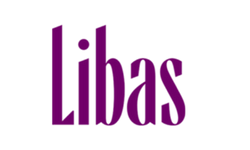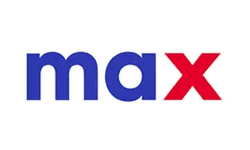AI - Driven Growth Solutions
SEO for Insurance Domains
Increase Policy Sales & Lead Generation

Infidigit is a CMO’s most preferred partner
2.2B+
Organic Sessions
15M+
Leads Generated
100+
Case Studies
60+
Awards & Recognitions
We are the trusted partners for brands to achieve organic success






































































KNOW ABOUT Insurance SEO
What is Insurance SEO
Insurance SEO refers to a marketing approach that focuses on the insurance industry. Its main objective is to optimize content so that it becomes more visible and ranks higher on search engines like Google. The ultimate goal is attracting relevant traffic to insurance websites by ensuring they appear prominently in search results.
Given the nature of the insurance market, where consumers increasingly rely on the internet for information, SEO becomes crucial. This process involves identifying and incorporating keywords. Phrases that potential clients might use when looking for insurance-related services. Additionally, creating high-quality content while designing user websites and obtaining backlinks from sources are all integral aspects of insurance SEO.
Furthermore, understanding the intricacies of insurance-related keywords – such as differentiating between tail and short tail variations – as well as targeting location-specific terms brings a level of sophistication to this digital marketing strategy. Insurance SEO goes beyond achieving rankings; it aims to provide users with a seamless online experience while positioning insurance companies as authoritative and trustworthy entities in the digital realm. In summary, insurance SEO serves as a dynamic tool for insurers who want to navigate the complexities of the marketplace successfully.
Understanding the Importance of SEO for Insurance Agencies
Why is SEO crucial for insurance companies?
In the world of insurance, SEO plays a crucial role in ensuring the success and longevity of companies. Firstly, SEO helps increase visibility, making it easier for potential clients to discover and access the services provided. As most consumers nowadays rely on search engines to research and select insurance providers, establishing a presence is essential.
Secondly, SEO builds credibility and trust. When a company appears on the search results page, it signals to users that they’re reputable and authoritative in their field. This level of trust is fundamental in an industry like insurance, where reliability and dependability are essential.
Furthermore, SEO allows insurance companies to target demographics and geographic locations effectively. Businesses can tailor their online presence to attract their ideal customer base by optimising keywords and employing SEO techniques.
In summary, SEO is not a tool but an essential strategy for insurance companies seeking success in today’s digital era. It enhances not only visibility and credibility but also enables companies to establish meaningful connections with their target audience. This ultimately drives business growth and prosperity.
Benefits of SEO for insurance agencies
Search Engine Optimization (SEO) offers a multitude of benefits for insurance agencies navigating the competitive digital landscape. Firstly, SEO enhances online visibility, ensuring that potential clients find your agency when searching for insurance-related services. By strategically incorporating relevant keywords and phrases, your website becomes more discoverable, driving organic traffic and, increasing the chances of lead generation.
Secondly, a well-optimized website attracts visitors and, also provides a positive user experience. User-friendly design, straightforward navigation, and fast loading times contribute to customer satisfaction, potentially translating into higher conversion rates. Additionally, SEO emphasizes creating quality content, positioning your agency as an industry authority. Regularly updating your blog with informative articles, case studies, and success stories not only engages visitors but also builds trust and credibility.
Furthermore, SEO is a cost-effective marketing strategy. Compared to traditional advertising methods, the long-term benefits of SEO continue to compound over time. It’s an investment that keeps on giving, as high-quality content and backlink strategies contribute to sustained online relevance.
In summary, the benefits of SEO for insurance agencies are manifold—ranging from increased visibility and lead generation to improved user experience and cost-effectiveness. Embracing SEO is not just a choice; it’s a strategic imperative for insurance agencies aiming for sustained digital success
We create success stories like these for your brand
Strategies
Key Components of an Effective Insurance SEO Strategy
1. On Page
On-page SEO is a fundamental aspect of optimizing web pages to enhance their search engine visibility and user experience. It primarily involves optimizing individual pages by strategically placing relevant keywords, creating high-quality content, and ensuring a user-friendly design. This process includes optimizing meta tags, headers, and images, as well as improving overall page structure. On-PageOn Page SEO not only aids search engines in understanding the content but also provides a better experience for visitors. By focusing on elements within the website itself, such as content relevance and page speed, On-PageOn Page SEO contributes significantly to higher search engine rankings. It’s about creating a seamless environment where search engines can easily index and understand the content, ultimately leading to improved visibility and accessibility for users.
2. Off Page
Off-page SEO refers to the optimization strategies implemented outside of a website to strengthen its presence and authority. It involves cultivating a reputation and establishing credibility across the digital realm. This is primarily accomplished through link-building initiatives, engagement on social media platforms, and other external factors that contribute to the overall authority of a website. Off-page SEO holds significance as search engines like Google take these signals into account when assessing the relevance and importance of a website.
On-page SEO focuses on optimizing elements within the website itself. On the other hand, off-page SEO revolves around activities conducted elsewhere on the internet to elevate the standing of a site. It encompasses creating high-quality backlinks from sources, nurturing a presence on social media platforms, and actively engaging with the online community. These endeavors enable websites to enhance their search engine rankings, increase visibility, and ultimately attract an audience. Off-page SEO can be likened to building a network of connections and earning endorsements in the landscape of cyberspace.
3. Local SEO
Local SEO, or Local Search Engine Optimization, is a digital marketing strategy focused on enhancing the online visibility of businesses in a specific geographic area. In simpler terms, it’s about optimizing a company’s online presence to attract local customers. This is particularly crucial for brick-and-mortar businesses aiming to draw nearby foot traffic. Local SEO involves various tactics, such as optimizing Google My Business profiles, acquiring local citations, and encouraging customer reviews. By aligning online information with the user’s location, search engines can provide more relevant results. For example, when someone searches for an “Insurance agency near me,” Local SEO ensures that nearby coffee shops with solid online profiles appear prominently in search results. Ultimately, Local SEO helps businesses become more discoverable to their local audience, driving physical visits and increasing overall visibility in the community.

4. Content Marketing
Content marketing is a strategic approach to marketing that focuses on creating and distributing valuable, relevant, and consistent content to attract and engage a target audience. It aims to build trust and loyalty, ultimately driving profitable customer action. In the digital age, where consumers are inundated with information, content marketing stands out by providing valuable insights, entertainment, or solutions. It goes beyond traditional advertising, fostering a deeper connection with the audience through storytelling and informative material. Successful content marketing establishes a brand as an authority in its industry, resonates with the target audience, and contributes to long-term customer relationships. It involves careful planning, understanding the audience’s needs, and leveraging various channels such as blogs, social media, and videos to deliver a cohesive message that adds value to the audience’s experience.
5. Technical Optimization
Technical optimization is the backbone of a robust online presence. Having a company heavily relies on technical optimization. This involves tuning the aspects of a website to ensure it performs at its best and provides an excellent user experience. Technical optimization includes elements like improving website speed, making it mobile-friendly, and ensuring indexing by search engines. By optimizing the foundation of a website, businesses can significantly boost their search engine rankings, resulting in visibility and increased organic traffic.
When it comes to optimization, one crucial aspect is addressing any issues that may hinder search engine crawlers from navigating and indexing the site. This involves fixing links, establishing clean and logical URL structures, and optimizing images for loading times. It is also essential to prioritize responsiveness due to the use of mobile devices.
Ultimately, technical optimization goes beyond meeting search engine requirements; it directly impacts user satisfaction. An optimized website not only ranks higher in search results but also offers visitors a seamless and enjoyable browsing experience. This contributes to engagement levels and conversion rates. In today’s changing landscape, mastering technical optimization is crucial for businesses aiming to thrive online.
6. Keyword research
Keyword research is the cornerstone of any successful SEO strategy. It involves identifying and analyzing the specific words and phrases potential users are likely to type into search engines when looking for information or services. By understanding the language and queries of your target audience, you can optimize your website’s content to align with their needs. Effective keyword research not only improves your site’s visibility in search engine results but also helps you create relevant and valuable content that resonates with your audience. It’s a dynamic process that requires staying attuned to industry trends, monitoring competitors, and adapting to changes in search algorithms. In essence, keyword research is the compass guiding your online presence, ensuring your content is not just seen but also appreciated by those actively seeking what you have to offer.
7. Keyword to URL Mapping
Keyword-to URL Mapping is a process that involves aligning keywords with their corresponding URLs on a website. This careful mapping helps improve search engine optimization efforts by ensuring that the right keywords are spread out effectively across the site’s pages. It basically acts as a guide for search engines, helping them understand the theme of each page based on its assigned keywords. This practice not only boosts the visibility of the site but also enhances the user experience by providing content that precisely matches what they’re searching for.
Effective keyword-to-URL mapping plays a role in achieving search engine rankings because search algorithms recognize the connection between user queries and the content offered on particular pages. In essence, it’s a part of SEO strategy that optimizes a website’s structure to communicate effectively with search engines and deliver content that resonates with the target audience.
8. Title Tag & Meta Description
Crafting effective title tags and meta descriptions is paramount for driving organic traffic and enhancing user engagement. Title tags act as concise descriptors, strategically incorporating relevant keywords to ensure visibility in search results. For insurance-related content, this may involve highlighting specific coverage types, benefits, or competitive advantages. Meanwhile, meta descriptions serve as persuasive snippets, summarizing the page’s insurance offerings and encouraging click-throughs. By tailoring these elements to address user intent and industry-specific queries, insurance websites can optimize their online presence, attract targeted audiences, and, ultimately, increase conversion rates in the competitive digital landscape.
9. User Experience
User experience (UX) is the holistic impression a user has when interacting with a product or service. In essence, it encapsulates the user’s feelings, perceptions, and overall satisfaction throughout their journey. It goes beyond just the functionality of a website or application, encompassing aspects like ease of use, accessibility, and aesthetic appeal. A positive UX ensures that users can navigate a platform effortlessly, find information intuitively, and accomplish tasks without frustration. It’s about creating a seamless, enjoyable, and memorable interaction that encourages users to return. Companies invest in UX design to enhance customer loyalty, increase engagement, and differentiate themselves in a competitive market. Ultimately, a well-crafted user experience is a crucial factor in building a solid and positive relationship between users and digital products.
10. Internal Linking
Internal linking plays a role in SEO by placing hyperlinks within a website’s content to connect to other pages on the same site. Not only do these links not make it easier for users to navigate the website, but they also have an impact on search engine algorithms. By establishing a network of links, you create a structure that helps search engines understand the importance and layout of different pages. This ultimately improves your website’s SEO performance. Moreover, internal linking distributes page authority and ranking power across pages, boosting the visibility of content. To summarize, mastering linking is an SEO strategy that enhances user experience, strengthens site architecture, and contributes to higher search engine rankings.
11. Header tags
Header tags play a pivotal role in structuring content for optimal search engine visibility. These tags, ranging from H1 to H6, define the hierarchy of information on a webpage. The H1 tag represents the main heading, signaling the primary topic to search engines. Subsequent titles, like H2 and H3, break down content into sections and subsections, providing a clear roadmap for both users and search engine crawlers.
Search engines prioritize header tags when indexing content, considering them as critical indicators of the page’s thematic relevance. Properly utilizing header tags enhances the user experience by making content more scannable and digestible. Significantly, incorporating relevant keywords into these tags can positively impact SEO, as search engines attribute significance to the keywords within headers.
In essence, header tags contribute not only to the structural organization of content but also to the overall SEO performance of a webpage. Ensuring a logical and keyword-rich hierarchy through header tags is a fundamental practice for web admins aiming to boost their site’s visibility and relevance in search engine results.
There is one plugin named “Seo header highlighter.” It helps you to get the header from H1 to H6. Below is the Screenshot for your reference.
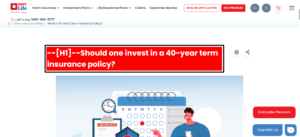
12. Image Optimization
Image optimization is a critical component of SEO, playing a pivotal role in enhancing a website’s performance and user experience. In the context of SEO, image optimization involves compressing and correctly formatting images to reduce file sizes without compromising quality. This not only ensures faster page loading times, a crucial factor for search engine rankings, but also contributes to improved user satisfaction. When search engines assess a website, they consider factors like page speed and overall user experience, making optimized images an essential element for better SEO outcomes. By incorporating descriptive file names and alt text for ideas, webmasters can also leverage the SEO potential of images, making their content more accessible and relevant to search engine algorithms. In essence, image optimization is not just about aesthetics but a strategic step towards a more efficient and SEO-friendly website.
If the image is not optimized, it leads to the webpage getting loaded at a slow speed, which gives a bad user experience.
13. Guest posting and link outreach
Guest blogging and reaching out for links are parts of SEO strategies. Guest blogging involves creating and publishing content on websites relevant to your industry. This does not establish your expertise. It also generates valuable backlinks to your site. When reputable websites host your content, it sends a signal to search engines that your content is reliable and pertinent, which helps improve your SEO rankings. On the other hand, link outreach is the effort to obtain backlinks by contacting other websites within your niche. It’s about building relationships and persuading website owners to link to your content. High-quality backlinks from sources enhance the credibility of your website in the eyes of search engines, resulting in increased visibility and improved SEO performance. Both guest blogging and link outreach are approaches aimed at expanding your presence, fostering collaborations, and ultimately boosting the ranking of your website on search engines.
14. Social media marketing for insurance agencies
Social media marketing for insurance agencies is an integral component of a comprehensive SEO strategy. In the digital era, leveraging social platforms not only enhances brand visibility but also contributes significantly to search engine rankings. By crafting compelling and shareable content on social media, insurance agencies can generate backlinks and drive traffic to their websites. Social signals, such as likes, shares, and comments, are increasingly factored into search engine algorithms, influencing a website’s authority. Integrating relevant keywords in social media posts and profiles further reinforces the alignment between social content and SEO objectives. Additionally, social media platforms serve as an avenue for engaging with the audience, fostering trust, and establishing brand authority—all of which positively impact a website’s SEO performance. In essence, a well-executed social media marketing strategy not only expands the online presence of insurance agencies but also synergizes with SEO efforts, creating a more robust and effective digital marketing approach.
15. Press Release
A press release plays a role in the world of SEO by helping businesses gain online visibility and recognition. Essentially it is an persuasive document that aims to inform the media, industry influencers and the public about developments within a company. From an SEO perspective, incorporating keywords and phrases into a press release can significantly improve search engine rankings. By optimizing the content with terms related to the company’s industry, services, or products, search engines can easily. Display the press release leading to an increase in organic traffic. Furthermore, including backlinks to the company’s website within the press release can boost its authority. Positively impact its SEO performance. Ultimately, a crafted press release not only communicates important updates but also forms an essential part of a comprehensive SEO strategy that contributes to better online presence and visibility on search engines.
16. Importance of local SEO for insurance companies
Local SEO is a game-changer for insurance companies looking to establish a robust digital presence in their local markets. In a world where consumers increasingly rely on search engines to find local services, optimizing for local SEO is imperative. By incorporating location-specific keywords, insurance companies can ensure their services appear prominently in local search results. This not only enhances visibility but also attracts highly targeted leads—individuals actively seeking insurance services in their vicinity. Furthermore, local SEO helps businesses appear in Google’s “Local Pack,” a coveted section that prominently showcases relevant businesses in a specific area.
This visibility boost can significantly improve a company’s chances of attracting local clients in the competitive insurance landscape, where trust and proximity matter. Local SEO acts as a digital storefront, making it easier for potential clients to discover and choose a local insurance provider. Overall, investing in local SEO is not just about online visibility; it’s about establishing a solid local presence, fostering community trust, and staying ahead in the digital race.
Local SEO helps you to rank locally on the keywords like “near me” or “City name.” Below is the Screenshot for the same
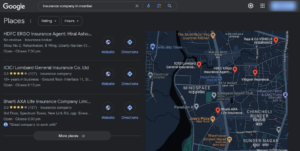
17. Google My Business optimization
Optimizing your Google My Business (GMB) is a part of an SEO strategy that can significantly enhance your online presence. In today’s world, where local searches are dominant, it’s vital to ensure that your GMB listing is not only complete but also optimized. Start by providing all the information, such as business hours, contact details, and a captivating description of your business. Use high-quality images to create a profile that catches the eye of customers. Strategically incorporate keywords into your business description and services to improve your search rankings significantly.
Furthermore, encouraging customers to leave reviews as feedback not only attracts new customers but also establishes credibility with search engines. Regularly updating your GMB listing with posts, announcements, and promotions will keep your information up to date. Engage your audience effectively. Ultimately, optimizing Google My Business involves more than sharing information; it’s about utilizing every element to align with SEO best practices and stand out in local search results.
18. Customer reviews and ratings
Customer reviews and ratings play a pivotal role in SEO strategies. In the digital age, potential customers heavily rely on reviews to make informed decisions. Search engines, recognizing the significance of user-generated content, factor in studies when determining search rankings. Positive reviews not only enhance the credibility of a business but also contribute to higher click-through rates. Incorporating customer testimonials on your website can be a powerful SEO tactic, as authentic feedback adds unique, relevant content that search engines value.
Moreover, actively encouraging customers to leave reviews and promptly addressing any negative feedback demonstrates a commitment to customer satisfaction, which can positively impact your online reputation and, consequently, your SEO performance. Embracing customer reviews as a strategic SEO asset is vital to building trust, engaging users, and ultimately boosting your website’s visibility in search engine results.
19. Creating engaging and relevant content
When it comes to improving search engine optimization, the key to success for insurance topics is creating content that genuinely connects with readers. Make sure to include keywords in your content while keeping it informative and friendly for search engines. Share insights about industry trends, offer expert advice, and address concerns. By incorporating terms, you’ll not only engage your audience but also show search engines that your content is a trustworthy source for related queries. Boost your presence with content that effectively communicates with both your readers and search algorithms.
20. Video content and its impact on SEO
In the dynamic landscape of SEO, the integration of video content has become a game-changer. Videos not only engage users visually but also hold immense potential for enhancing search engine optimization. Search engines, especially Google, prioritize diverse and engaging content, and videos perfectly fit the bill. When embedded strategically within a website, videos contribute to lower bounce rates, increased time spent on the page, and improved user experience—all crucial factors considered by search algorithms.
Below is the example of the video content embedded, which explains the HDFC Term plans.

21. Importance of Infographics
Infographics play a pivotal role in enhancing the effectiveness of SEO strategies. In the dynamic world of search engine optimization, visual content, such as infographics, serves as a powerful tool to convey complex information in a visually appealing and digestible format. Search engines, like Google, prioritize user experience, and infographics contribute significantly to this aspect.
In SEO, the inclusion of visually engaging elements, such as infographics, enhances the overall appeal of a webpage, potentially increasing the time users spend on the site. This dwell time is a crucial factor for search engine rankings, signaling to algorithms that the content is relevant and valuable to users. Additionally, infographics provide an opportunity for the incorporation of strategic keywords and relevant alt text, further optimizing the content for search engine algorithms.
The example below shows how to plan retirement. For example, at a young age, start investing, and when you retire, you can live your life peacefully.
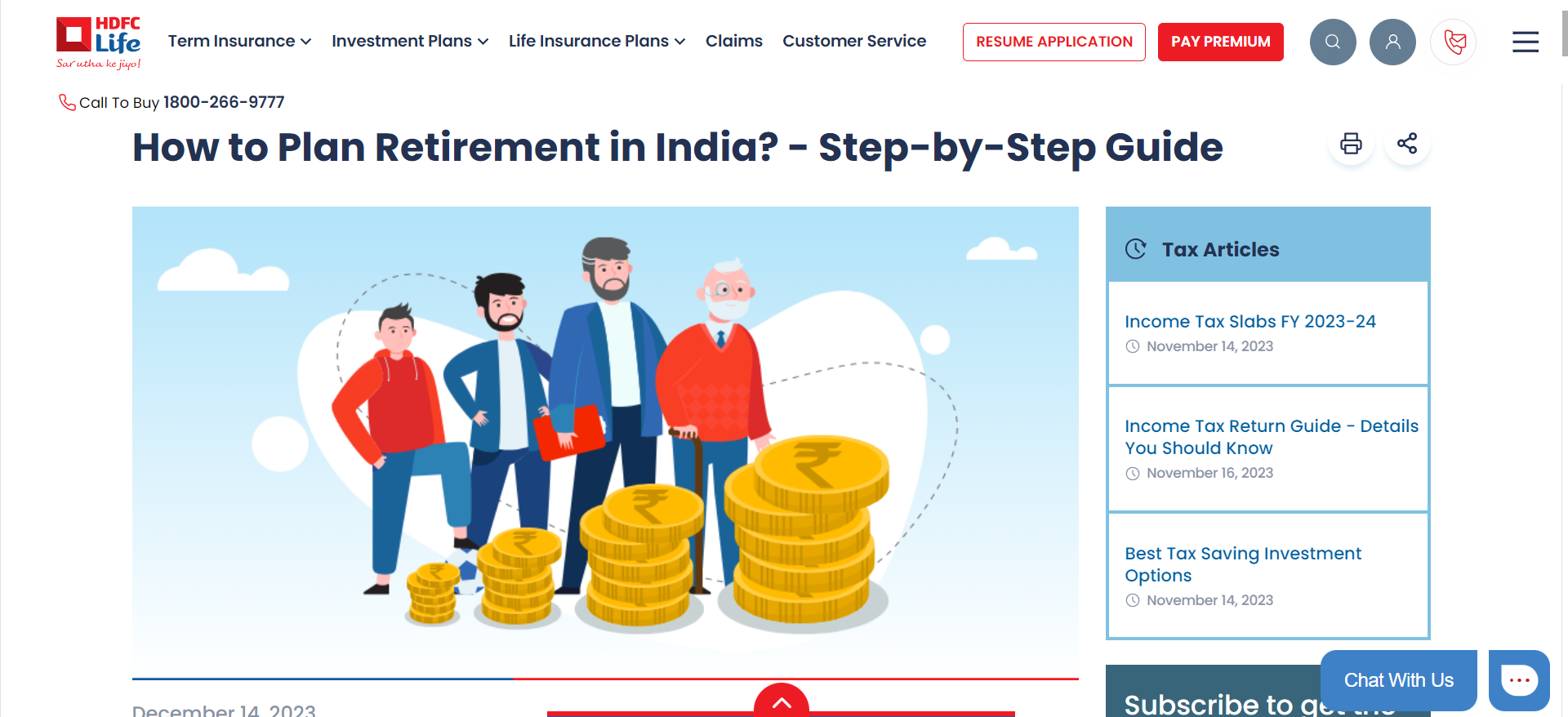
22. User Generated content
In the changing world of SEO, User Generated Content (UGC) has become a tool, especially in the shape of customer reviews and comments. These genuine accounts of user experiences not only offer perspectives for potential customers but also have a substantial impact on search engine rankings.
Customer reviews play a pivotal role in SEO, acting as a form of social proof that enhances the credibility of a business. Search engines, recognizing the importance of user feedback, often prioritize websites with a substantial volume of positive reviews. The constant influx of fresh content from reviews and comments signals to search engines that the website is active and relevant, positively impacting its SEO performance.
23. Utilizing Google Analytics for tracking
Leveraging Google Analytics for tracking enables comprehensive insights into website performance. This robust tool allows users to monitor critical metrics such as website traffic, user engagement, and conversion rates. By analyzing data provided by Google Analytics, businesses can make informed decisions to optimize their online presence. From understanding user behavior to evaluating the success of marketing strategies, Google Analytics serves as an invaluable resource for tracking and improving various aspects of a website, ultimately contributing to a more effective and data-driven online approach.
Google Analytics helps you to get insights into your domain. The screenshots below help you get the organic session and N number of metrics.
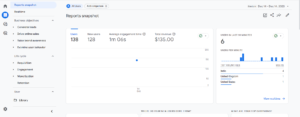
24. Google Search Console for Website Insights
Google Search Console (GSC) is a pivotal tool for webmasters, providing crucial insights into website performance. With GSC, you can track metrics like clicks, impressions, click-through rate (CTR), and ranking for your domain. This user-friendly platform offers a comprehensive view of how your site interacts with Google’s search results. Analyzing these metrics allows you to fine-tune your SEO strategy, optimizing content for better visibility. GSC’s intuitive interface and detailed reports make it an indispensable resource for understanding and improving your website’s search engine presence.
Google’s search console helps you get the data of clicks, impressions, CTR, and ranking. Below is the Screenshot.

25. Ranking Tool: Infigrowth
A crucial aspect of online visibility. Understanding how your chosen keywords perform is like having a roadmap to digital success. It’s about knowing where your website stands in the eyes of search engines.
Infigrowth by Infidigit is your trusted companion in the quest for digital supremacy. This ingenious tool empowers you to effortlessly track your keywords’ ranking, giving you the insights needed to climb the search engine charts. With Infigrowth, take charge of your website’s destiny and watch as your keywords become the stars of the online show. Elevate your digital strategy, and let Infigrowth guide you to the pinnacle of keyword mastery.
Infigrowth tool helps you to rank tracking tools that monitor your website rankings in a personalized way.
Below is the Screenshot of the Infigrowth.

26. CRO: Enhancing User Experience
Conversion Rate Optimization (CRO) plays a role in improving the user experience on a website and seamlessly aligns with SEO efforts. CRO focuses on optimizing aspects of a site to enhance its conversion rates, perfectly complementing the user approach of SEO. By refining elements like website design, content, and calls to action, CRO ensures that visitors not only discover the site but also engage and convert. This harmonious relationship between CRO and
SEO is based on their shared objective of providing a satisfying user experience.
Implementing CRO strategies enhances the relevance and quality of a website, which search engines highly value. Search engines strive to deliver the results to users, and a site optimized for conversions is more likely to meet these criteria. Therefore, in the realm of SEO, investing in CRO goes beyond being a strategy; it becomes a requirement. These two practices work hand in hand, creating a landscape where user experience takes the stage and continually evolves for optimal outcomes in both conversion rates and search engine rankings.
PLAN
SEO Packages and Plans
Lite
Boost your visibility and drive initial growth
- 500 Keyword tracked weekly
- 30 pages optimised
- Bi-Annual reviews with Seniors
Standard
Elevate your website to achieve higher visibility
- 1000 Keywords tracked weekly
- 50 pages optimised
- Quaterly reviews with Seniors
Pro
Supercharge your websites growth by advance strategies
- 1500 Keywords tracked weekly
- 70 pages optimised
- Monthly reviews with Seniors
Enterprise
Unleash the full potential of your websites presence
- 2500 Keywords tracked weekly
- 200 pages optimised
- Monthly reviews with Seniors
Summary
Building a Comprehensive Insurance SEO Strategy for Long-Term Success
Crafting an Insurance SEO strategy involves crucial elements that play a significant role in maximizing visibility and engagement. On-page optimization is about strategically placing keywords in titles, meta descriptions, and content to signal search engines about the content’s relevance. Off-pageOff page strategies, such as, acquiring quality backlinks from sources, contribute to the authority of the website, which is essential for higher search rankings.
When it comes to insurance agencies targeting areas, local SEO becomes imperative. This includes optimizing business listings, accumulating reviews, and incorporating location keywords to improve visibility in local searches. Content marketing is another aspect where creating blog posts, case studies, and engaging videos that resonate with the target audience helps establish the insurance agency as an industry expert.
Technical optimization focuses on elements that are crucial for search engine crawling and indexing. It involves ensuring fast loading times, mobile optimization, and maintaining a website to provide users with a browsing experience – something search engines take into account when determining rankings. By diving into each component of an Insurance SEO strategy, we can develop a customized plan that sets the stage for long-term online success. Let’s explore these elements in greater detail to unlock their full potential.
Our clients talk about their transformative growth journeys.


Carla Rabe

The Iconic


Achint Setia

Carla Rabe
Product Lead at Superbalist
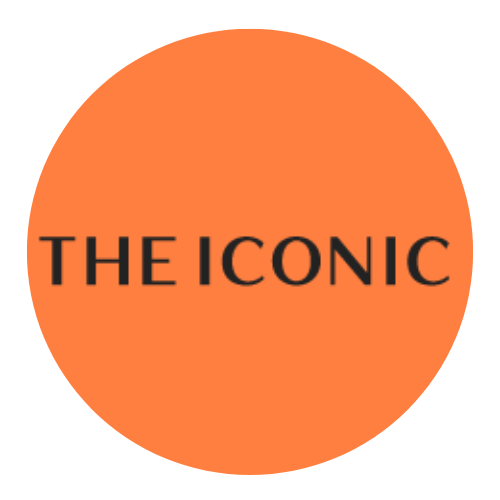
The Iconic
Head of SEO at THE ICONIC

Achint Setia
VP Marketing at Myntra


Suresh Chettiar


Manish Dubey


Awant Bhagat

Suresh Chettiar
Marketing and Product Head at NUUU

Manish Dubey
CMO, ICICI Prudential Life Insurance Company Limited

Awant Bhagat
Head of Digital Marketing at Stader


Vipul Oberoi


Lara Salomon

Vipul Oberoi
Director - Marketing, CSR & Learning Solutions at D&B

Lara Salomon
Marketing Specialist at Solid Systems


Anurag Goyal

Anurag Goyal
Sr. Manager - Digital Marketing at Extramarks


Altaf Saiyed
Founder of Traya

Altaf Saiyed
Founder of Traya


Aparna Acharekar


Rituj Kate

Aparna Acharekar
Programming Head at Zee5

Rituj Kate
SM – Product at Dream11


Nidhi Gupta


Manan Bajoria

Nidhi Gupta
Marketing Assistant at Tata Consumer Products

Manan Bajoria
AVP | Growth, Ixigo
Other Solutions
More Ways to Drive Results
Search Engine Optimization
Unlock higher rankings, quality traffic, and increased conversions through tailored award-winning SEO strategies.
Conversion Rate Optimization
Enhance your website that drives users to complete a desired action to become your customer.
Website Development
Latest web development frameworks, responsive design techniques, and robust backend systems to ensure your website is fast, secure & seamless.
App Store Optimization
Optimise your mobile app with our award-winning ASO strategies that will lead to higher rankings & installs on Play Store & App Store.
Content Writing
Craft your brand narrative efficiently with our skilled writers, tailoring content strategies to effectively convey your story.
Local SEO
Boost local visibility, attract quality traffic, and drive conversions with tailored Local SEO strategies.
YouTube SEO
Drive video growth, attract loyal subscribers, and amplify engagement with tailored strategies.
Amazon SEO
Enhance your Amazon presence, capture more buyers, and drive sales with custom optimization strategies.
Link Building
Strengthen your site’s authority, attract quality traffic, and improve SEO with expert link building.
Industries
Discover how we can help across various industries
Locations
We drive growth Worldwide, delivering solutions wherever you are
FAQs on Insurance SEO
How long does it take to see results from an insurance SEO strategy?
Implementing an insurance SEO strategy requires patience, as results take time to happen. Generally, it takes several months to begin seeing noticeable outcomes. Factors influencing the timeline include:
- The competitiveness of keywords.
- The effectiveness of content creation.
- The consistency of optimization efforts.
Search engines need time to index and rank content, and the competition within the insurance industry plays a role in the speed of results. Consistent, quality SEO practices, including keyword optimization, content updates, and backlink building, contribute to sustained, long-term success in improving search rankings and driving organic traffic.
Can a small insurance agency compete with larger competitors in SEO?
Size doesn’t determine success in SEO; strategy does. Small insurance agencies can compete by focusing on niche keywords, creating valuable content, and optimizing their websites for local searches. Tailoring SEO efforts to specific client needs, leveraging long-tail keywords, and building quality backlinks can elevate their online presence. Additionally, engaging in social media and utilizing Google My Business effectively can enhance visibility.
While larger competitors may have more resources, a well-executed SEO strategy allows small agencies to target a specific audience, providing personalized services that resonate, ultimately leveling the playing field in the digital landscape.
Is social media marketing important for insurance SEO?
How can insurance agencies adapt to the growing trend of voice search in SEO?
As the trend of voice search continues to grow, insurance agencies must adapt their SEO strategies to remain competitive. To optimize for voice search:
- Focus on long-tail conversational keywords that mimic natural language.
- Enhance local SEO efforts, as voice searches often have local intent.
- Ensure your website is mobile-friendly and provides concise, informative answers to common insurance queries.
Incorporating schema markup can also enhance search engine understanding of your content. By aligning SEO practices with the nuances of voice search, insurance agencies can position themselves to capture a broader audience and stay ahead in the evolving digital landscape.
How useful was this post?
0 / 5. 0











